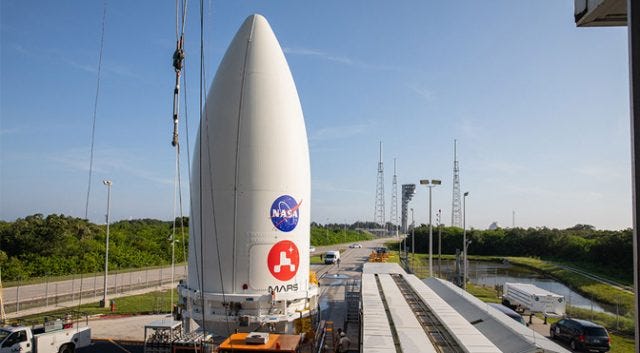Exploring Perseverance: NASA's Journey to Mars in 2021
Written on
Chapter 1: NASA's Perseverance Rover Prepares for Launch
NASA's Perseverance rover is set for its mission to Mars after extensive preparations. The agency secured the rover within its payload fairing and attached it to an Atlas V rocket this week. With favorable weather conditions, the latest Martian explorer will soon embark on its journey to the red planet.
On July 7th, NASA transported the rover to the Vertical Integration Facility at Space Launch Complex 41. Engineers elevated the payload atop the 129-foot (39-meter) Atlas V rocket, ensuring it was securely fastened and connected electronically. These connections will remain intact until approximately an hour post-launch, when the second stage will release Perseverance on its path to Mars.
NASA has devoted several years to the design and construction of Perseverance, which draws inspiration from the highly successful Curiosity rover. However, the engineering team has integrated crucial insights gained from previous missions. For instance, Curiosity's wheels suffered considerable damage from sharp Martian rocks, prompting the new rover to feature wheels made of a stronger aluminum with resilient titanium spokes.
The progress of Perseverance faced delays due to the COVID-19 pandemic, raising concerns that NASA might miss its launch window. Earth and Mars align favorably only every few years, meaning that a setback could have postponed the mission until 2022. Fortunately, NASA extended the launch window from an initial cutoff of August 11th to August 15th, allowing sufficient time for final testing before the rocket heads to the launchpad.

Section 1.1: The Planned Landing
Although an official launch date is yet to be confirmed, NASA has established a target landing date of February 18, 2021. This specific date aids mission planners in preparing for optimal conditions, such as surface lighting and satellite positioning. Perseverance is set to land in Jezero Crater, an area believed to have once been a lake in the planet's ancient history. Jezero Crater boasts layers of clay, a river delta, and remnants of volcanic activity, making it an ideal site for examining Mars' geological history and searching for signs of past life.
Perseverance will also carry the Mars Helicopter drone, designed to survey the terrain and potentially expedite the rover's exploration. While officially a technology demonstration, the helicopter's capabilities could prove invaluable. Additionally, the rover is equipped with a sample storage system to collect materials for possible return to Earth in a future mission.
Discover the excitement as NASA launches the Mars 2020 rover, Perseverance, aboard ULA's Atlas V Rocket!
Watch the Atlas V successfully launch NASA's Perseverance Mars Rover into space!
Chapter 2: Perseverance's Mission Goals
This restructured text reflects the original content's essence while using different wording and phrasing. The format and structure are adapted to meet reStructuredText requirements, including the insertion of the YouTube video directives with appropriate descriptions.